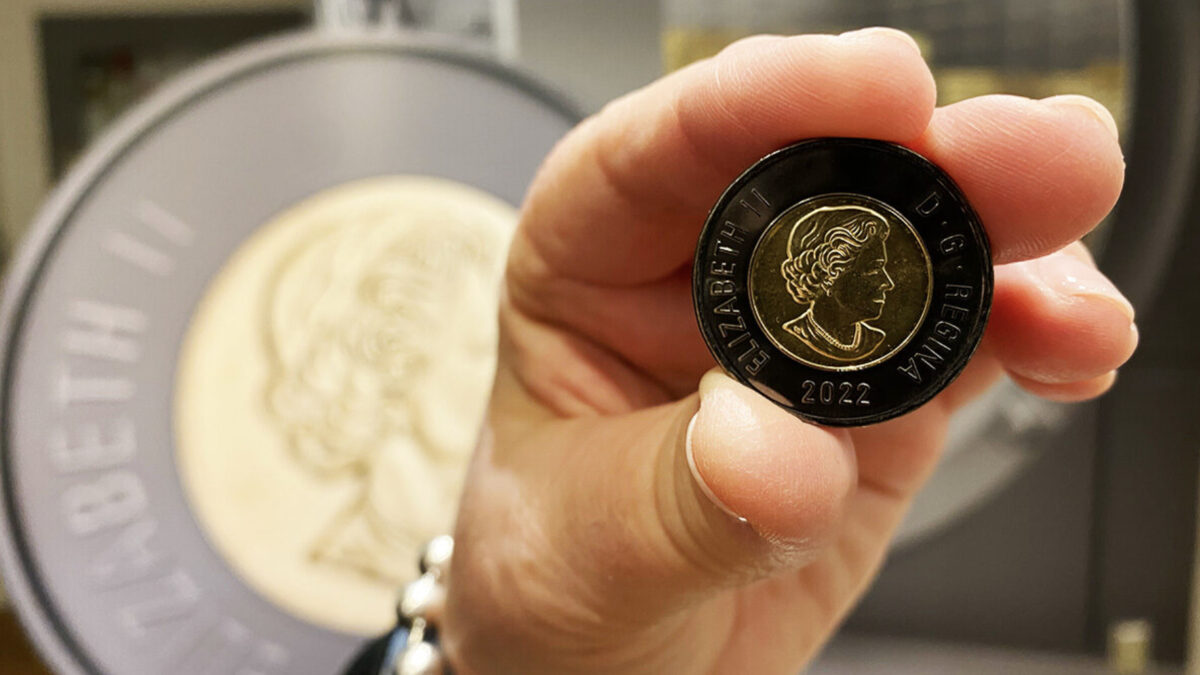The Royal Canadian Mint’s special black-banded toonie tribute for the late Queen Elizabeth II marks the end of an era, but the future face on Canadian coins remains unknown amidst discussions about national identity and Canada’s colonial history.
From Jan. 27-29, the Ottawa-based mint held coin exchange events in Ottawa and Winnipeg to allow members of the public to trade their bills and change for up to five toonies designed to honour the late monarch, who died on Sept. 8 at age 96.
“We like to give Canadians a piece of their history by making these coins available and easier to find,” said Alexandre Reeves, the mint’s senior manager of public affairs.
The event saw a wide range of participants of all ages, with small, eager hands grasping at the commemorative coin to aged, worn fingers gently holding the toonie.
“They wanted a keepsake, and there’s nothing more affordable than a circulation coin,” said Reeves.
The line flowed quickly, with each patron taking barely a minute for the exchange. Visitors could also purchase other commemorative memorabilia showcasing the likeness of the late monarch, but many left soon after they collected their black-banded coins.
One attendee, Tony Tsang, is an international student at the University of Ottawa. He said he’s not a coin collector.
![Visitors keep their winter coats on as they line up for the quick toonie exchange on Jan. 27 in Ottawa. After collecting their commemorative coins, visitors can snap a photo with the display honouring the late monarch. [Photo © Angel Xing/Capital Current]](https://capitalcurrent.ca/wp-content/uploads/2023/02/COIN_02.jpg)
“It’s just a toonie,” Tsang said. “Because I’m from Hong Kong and it was colonized by the British, I just want some souvenirs.”
Another visitor, historian Steve Talbot, said he usually collects old bills, but he figured the commemorative coins could be worth more to future generations.
“These are once in a lifetime,” Talbot said. “But for me, I’d like to see more historical figures than a monarch. It should be a Canadian on the coin.”
Since the Royal Canadian Mint began producing coins in 1908, the metal pieces have always had effigies of reigning monarchs to reflect Canada’s position as a Commonwealth country.
“What you put on there is very important; they leave a permanent record of whatever you’ve displayed,” said Reeves. “Coins are an important vehicle for preserving your stories and ensuring they live on through the generations.”
‘In the post-Truth and Reconciliation Commission age, in an age where we are taking the colonial roots of this country seriously and trying to undo the harm and violence of colonialism, singling out a symbol of the British empire to celebrate and commemorate seems counterintuitive.’
— John Walsh, Carleton University history professor
According to Carleton University history professor John Walsh, the co-director of the Carleton Centre for Public History, coins are a critical component of commemorative history. He said that coins are also a way for the government to nurture a sense of shared identity and culture.
“The image of the Queen is bound up in something unique,” Walsh said. “People have grown up with this Queen as the figurehead, as someone on this currency.”
Walsh added that he understands for many, the Queen is not a symbol of Britishness; instead, she is a familiar face to many generations, and the special toonie helps provide a sense of closure on her life.
However, Walsh said the times have changed since Elizabeth became Queen in 1952.
“In the post-Truth and Reconciliation Commission age, in an age where we are taking the colonial roots of this country seriously and trying to undo the harm and violence of colonialism, singling out a symbol of the British empire to celebrate and commemorate seems counterintuitive,” he said.
“Continuing to put symbols of the British monarchy on any currency, any kind of national symbol perpetuates a very tired, outdated understanding of the history of Canada.”
According to Reeves, the mint aims to broaden understandings of a diverse Canadian identity through their commemorative coins. In 2022, the federal agency celebrated legendary Black Canadian jazz musician Oscar Peterson, hockey’s historic 1972 Summit Series between Canada and the Soviet Union and 19th-century telephone inventor Alexander Graham Bell.
![Timeline comparing key points in Canada’s history and the Royal Canadian Mint’s development. [Infographic © Angel Xing/Capital Current]](https://capitalcurrent.ca/wp-content/uploads/2023/02/COIN_Infographic-893x1200.jpg)
While the mint is working on increasing the scope of representation on Canada’s currency, there remains a longstanding lack of Indigenous peoples depicted on coins and bills, especially women.
For this reason, the Native Women’s Association of Canada held an exhibition in January called “Change the Bill” at Toronto’s The Local Gallery to raise awareness about the need to better represent Indigenous women in Canadian society.
“This project is what reconciliation looks like in action,” said Irene Goodwin, a member of the Ojibwe First Nation and the NWAC’s director of policy and programs for culture and art. Commemoration of First Nations, Inuit and Metis people is a core component of the calls to action in the Truth and Reconciliation Commission.
“The images on our currency show who we see worthy of recognition and suitable for remembrance,” she said. “They’re symbols of whose stories we’re telling our children, and on the flip side, whose stories we’re not.”
The project featured 11 proposed redesigns of Canada’s $20 bill by Indigenous artists, each one depicting powerful images of leaders such as Second World War aerial photo reconnaissance technician Margaret Pictou — a member of the Eel River Bar Mi’kmaq First Nation in New Brunswick — and Autumn Peltier, an Anishinaabe Indigenous rights advocate from the Wiikwemkoong First Nation on Manitoulin Island, Ont.
![“Change the Bill” designs from the website of the Native Women’s Association of Canada, which is urging institutions like the Royal Canadian Mint and Canada Post to depict Indigenous women in commemorative symbols. [Photo © Angel Xing/Capital Current]](https://capitalcurrent.ca/wp-content/uploads/2023/02/COIN_03.jpg)
“For too long, we’ve been relegated to the footnotes of Canadian history,” Goodwin said. “Our young people need to know who the trailblazers are so they, too, can reach for the stars.”
Reeves said the mint is not currently involved in any discussions or deliberations about whose image will replace the late monarch’s portrait on Canadian coins, though no laws or regulations require that the country’s head of state be depicted on the country’s currency.
“This is the first time in 70 years that the government has a decision to make on this,” he said. “We’re happy to support them in their decision and turn their wishes into coins.”
The central bank of Australia recently announced that King Charles III will not be on the new $5 bill, though he will be on Australian coins. Instead, the central bank will replace the monarch’s portrait with “a new design that honours the culture and history of the First Australians.”
Britain’s postal service has just issued the first stamps bearing the likeness of King Charles.
Goodwin said the passing of the Queen represents an opportunity for change in Canada.
“Coins are something that every Canadian, regardless of where they are, will carry, so this is a moment to educate the public and build a more inclusive society.”




